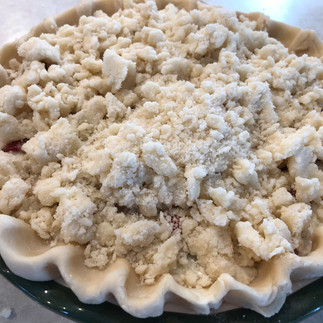Rhubarb is Your Friend: The Best Cold-weather Vegetable for Pies, Jams, Cakes, and Curd
- Heather Carter
- Apr 6, 2022
- 3 min read
Updated: Feb 2

I grew up on my great grandmother's rhubarb custard pie--and even as I child, I loved it! Whenever I think of spring bakes, I think of this magnificently tart and tasty vegetable. The Rocky Mountain states provide a superb environment for rhubarb, though it grows well in almost any northern location. The plant is a perennial vegetable that withstands cold weather magnificently--in fact, it needs a fair degree of coldness in the winter to thrive. Rhubarb is often harvested from early spring through early summer. The many advantages to growing rhubarb include its abundant growth, low cost, easy maintenance, and sheer versatility in cooking.
You may be most familiar with rhubarb in desserts, where its tartness balances out both the sweetness of sugar and richness of eggs and butter. It's no surprise that sweet and tart treats are where I love rhubarb the most. However, rhubarb can also be used in savory chutneys and salsas. It makes a great addition to pork chop, roasted chicken, and lamb.
Additionally, rhubarb is easy to propagate. You can split a fully-grown rhubarb plant in half with your shovel in the early spring and move it to another location (which you want to do fairly often to reinvigorate the roots). I've taken parts of my grandmother's, my father's, and my own plants on moves across cities and states. Doing so makes me feel like I'm carrying some of my ancestry--wisdom from my grandmothers, wisdom from my roots--with me into my present life. I feel strengthened by these connections, strengthened by holding their knowledge and teaching it to my children and others. So, with great regard and fond remembrances of my great grandmother, here are some of my favorite rhubarb eats:
Eating Rhubarb
Rhubarb Custard Pie - a richly satisfying pie with a crumb topping and velvety texture. Click on the link for the recipe.
Rhubarb Crumb Cake - a moist and filling coffee cake, perfect for a Sunday morning. Click on this link for the recipe.
Rhubarb Curd - made with butter, eggs, and rhubarb juice, this is a delectably smooth spread for toast, English muffins, German pancakes, or even an ice cream topping.
Growing Rhubarb

Rhubarb is not a plant you raise from seed. You can pick up starter plants at almost any local nursery, but even better, see if your friends or neighbors have an overgrown rhubarb plant they'd like to split! Use a shovel to cut cleanly through the rhubarb plant in early spring. Split the plant in half or take out a good third, digging down at least two feet and transferring the whole portion in one shovel-full to a pot to transplant in another location. The rhubarb plant shown in the photo above could easily be split in half after having lived four years in its current location. After two weeks of early spring growth, the same plant's leaves begin to unfurl more liberally, as shown in the photo below. Stems will follow, allowing for harvest in another 4-6 weeks.

If you're planting rhubarb for the first time, space the plants at least four feet apart. In time, the space will easily be filled. Divide your rhubarb regularly, and give some to friends or family. You don't have to grow rhubarb in rows. It thrives equally well as a side plant, providing greenery in flowerbeds or just on the end of a raised bed.
Rhubarb is not a fussy plant. It's quite hardy, and an be grown in rocky or clayish soil. Still, in order to avoid buildup of pests around your plant, harvest and remove dead leaves regularly. Decaying leaves and stems can feed the soil, but you may not want the pests they attract to invade your other produce. Move decaying plant matter to a compost pile instead.
When you're ready to harvest, pull gently on the bottom of a stalk to remove the entire stem from the plant. Harvesting stems allows the sun to reach more of the plant, and encourages continued growth of new stems as the season continues.
Finally, it should be noted that the leaves of rhubarb plants are toxic to both humans and other animals. Our dogs and cats never eat the leaves, but I wouldn't plant rhubarb in my chicken run. When I have let chickens roam the same area as my rhubarb, I've kept one eye on the birds. You may have a chicken whose curiosity about the leaves can't be contained, in which case you may have to find a more suitable location for your plant.








Comments